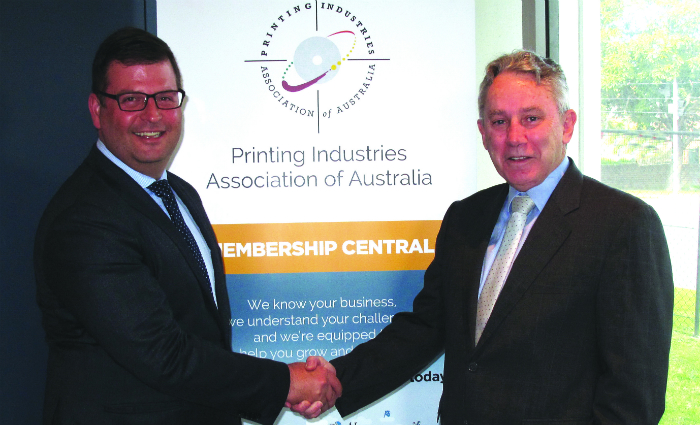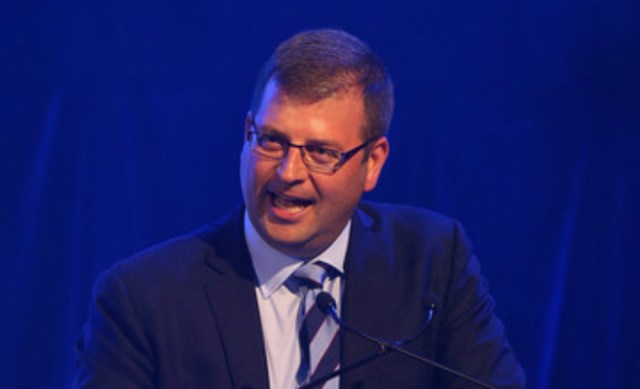
Jason Allen knows he has a big task ahead of him as the new PIAA chief executive. Life for printers in the new millennium is arguably tougher than it has ever been. Digital technology has disrupted the entire medium with no sign of slowing down, and not every business has been able to keep up. As owners, salespeople and press operators grapple with the new reality, so must the peak body charged with representing their interests and supporting print business owners in these challenging times.
But Allen has been here before, spending four years helping turn the NSW Waratahs rugby union team from a struggling also-ran into a record-breaking champion. He looks at the job before him and sees only opportunity. “I love a challenge and there is a significant challenge ahead for our industry,” he says. “This industry is moving so quickly that there is a lot to do in a short amount of time, but I am very excited to be part of what I can see in the future, and I hope I can add some value from my background in change management.”
Under Bill Healey, the PIAA has made brisk strides in the direction it knows it needs to go, offering a range of services including the acclaimed Future Print apprenticeship and business transformation program. The success of these and other initiatives made 2014 the best year it has had in quite some time, but Allen freely admits that there is still plenty of work to do. “Have we moved and developed in time over a period of time? No. Otherwise, we would not have had the great decline in member numbers – that is reality. We need to address that and we have a fair job ahead us,” he says.
Allen’s plan to reverse this trend and build on the foundation he has been given is an ambitious vision of targeted services that printers will want access to – and include a commitment to follow them through. Just weeks from being announced, it will be based on feedback from a wide range of printers around the country he has spoken to since taking office in July. “I am a big believer in authentic leadership, being fair dinkum and telling it how it is. I think you have to be a leader by behaviour – getting outcomes and assessing them regularly against a clearly aligned plan,” he says. “We are going to become a vision and values organisation and we will have a clearly articulated vision and core set of values that will create the behaviours of how we operate, and we will be accountable for them. We will also be highly service-orientated and the staff have really embraced this. We will be straight up with the industry and earn its respect with our actions.”
If this sounds different to rhetoric printers have heard from their top representative in the past, it is because Jason Allen is not your typical manufacturing industry association leader. While most of his predecessors at the PIAA spent their career on a running other industry bodies, he was wearing a suit and tie in a boardroom. Before signing on as Waratah’s chief executive in 2010 he headed up the Adelaide Clipsal 500 V8 Supercars event for two years and before that was national general manager of retail and consumer sales at Vodafone for four years. Though he refuses to compare himself to any of his predecessors and remains firmly focused on the task at hand, his years in marketing and regular media attention in the sports world appear to have given him the style of a polished communicator who speaks in guarded but consistently enthusiastic sentences – in contrast to Healey’s raw, unfiltered straight talk.
Being with the Waratah’s has made him used to passionate rugby fans with short memories and loud mouths, he is also not at all phased by what the industry thinks of him at this early stage of his tenure. His response to a ProPrint poll where only 17 per cent of respondents said he was a good choice for the job, compared with 38 per cent saying no and 45 per cent indifferent, is that it is ‘not a popularity contest’. “I’ve got a job to do and that is to support the industry,” he says. “Game on.”
Allen’s heavy corporate experience is a big reason why he was chosen to shake up the industry and help make it commercially viable and the landscape shifts around it. “He has a long record of success in leading turnarounds in big and small companies and has outstanding leadership skills that allow him to devise and implement strategies,” PIAA president David Leach says. “Allen built a good team at the Warathas that helped lead them to victory which is a testament to his leadership and communication skills that the industry needs.”
This view is supported by at least some of the wider industry, with one ProPrint commenter declaring in the wake of his appointment: “I would say if he could manage a financial and political basket case like the Waratahs, he should have the goods to work amongst us. I like Bill Healey as a person, but I’m glad the board have appointed someone with a more commercially orientated background.”
For his part, Allen sees similarities between his past and present positions that have made adjusting to life as an association CEO easier than one might think. “All the roles I have been in have had a heavy stakeholder management – rugby members, government, private enterprise – so there is quite a close alignment,” he says. “The significant difference is this role focuses on one industry, one that is changing rapidly which is pretty exciting. I don’t think industry verticals are what is important at the moment, we need to make sure that we are providing benefits to members, growing our membership base, and diversifying our services appropriately.”
Allen’s corporate background also means he has experienced the other end of the supply chain: Buying print, millions of dollars at a time. “I am passionate about all functions of marketing, having been a big acquirer of point-of-sale and print-based materials in the past, but also digital,” he says. Allen draws on his experience to explain how print businesses can reposition themselves for success by getting to know their clients better and paying attention to market research. “There are still consumers consuming and they want to consume, they want information, and we have an opportunity to provide that narrative whether it be via printed material, digital or a combination of the two, which is the Holy Grail for a lot of companies out there,” he says.
To get into this situation, Allen says printers should talk to their clients about their expected demand generation over the next few years and work with them to be a key part of their business, providing the solutions required as part of a multichannel marketing mix. “There are businesses spending a lot on marketing and I would be looking at ways to get a bigger chunk of that pie,” he says. “The more integrated you are in your approach to client needs, the more you can make it a profitable solution for everyone, and the more successful you will be.” Allen says the Australian population is growing and with increasing demand for consumable products there are lots of opportunities that could be considered in the ’consumable landscape’. “Retail companies, for example, are looking for an integrated marketing approach to drive traffic either in-store or online,” he says. The retailers then need insights into customer behaviour and interaction with the marketing, followed by the logistics requirements of delivery to customers. “These are all things that are created by the demand generated by print products,” Allen says. “So there are bolt-on business opportunities to provide a wonderful solution for a client.”
Allen does not sway from this optimism, consistently rejecting any negative narrative on the future of print in Australia, saying bright, vibrant and exciting times are ahead. Though he acknowledges many printers are ‘doing it tough’ and there are plenty of challenges, he asserts ‘they are less than the positives’ and that print is a top-ten industry player that provides considerable employment as well as value-adds to companies to whom it is an imperative part of business planning. “I’m an eternal optimist, I prefer to see opportunity rather than a black hole,” he says. “There are a lot of positives in our industry as well as a lot of challenges, but that is not different to other industries. I am not into the dour approach because that gets you nowhere. The realities are that every industry is going through significant change and if they say they are not then they are misleading all of us, because technology is becoming such an imperative of every part of a business’ function now. Our job as an association is to provide a stimulus that creates different levels of thinking to assist business in growing, and we are going to continue to improve on that and also look at expansion opportunities for our industry.”
Allen says the biggest issue in the printing industry is “the vertical integration of what consumers are demanding through online verticals and the combination of some of our members who have got significant investment in offset printing.” He says the challenge everyone in the industry has is to look at what they are investing in, how they are resourcing it with human capital, how to create sufficient demand to cover it. “There will be continued investment in printing both for offset and digital, but we are still trying to learn what the mix will look like,” he says, encouraging printers to look at customer research, talk to experts and start implementing change process based on the results. “I have spoken to a lot of members, some of whom are doing it tough, and my message has been please, please have a clear plan of whether you are re-entering the market and what that looks like, and what investment you require to do that into the future – or if you are exiting, consider what that process looks like and how you can make it the most profitable for you.”
While the narratives of diversification, lean manufacturing, value-adding and resilience are well established, the question is what role the PIAA can and should play in print’s transformation, and whether it is still able to serve members and would-be members effectively enough for it to be worth their while paying dues and taking up the services on offer. “The reason why the PIAA is seeing a decline in member numbers is due to the association models changing, member requirements changing, and that there are other industry bodies out there that can support different requirements for different members,” Allen says. “Also, when businesses are looking for cost savings, association membership is something that is easy to put a line through.”
However, Allen is confident the services the PIAA will provide will entice members to stay, and new ones to sign up, as they will be targeted towards what printers actually say they need and what will help them grow their businesses and build sustainable futures. “It will be how we service our members and of course creating the right product mix,” he says. “Successful businesses are never satisfied and we want to be a very spirited organisation which will mean we will always be restless to provide different responses as the market is changing.”
Key things he says printers he has talked to are saying they want is for the PIAA’s long-standing workplace relations and legal services to continue, and perhaps be expanded. They also want the association to keep being a strong advocate for their interests, in which it has had a number of wins recently, and lobbying of government and other industries on relevant issues.
Then there are training programs like Future Print “That has been a significant investment by the government and the association in assisting with some future thinking around where the industry is going and providing some resources, training and development in that space,” Allen says. “It was an extraordinary effort by the association to get that funding and there are a lot o f apprentices and staff that have taken advantage of it, but there is a lot more we can do there.”
The $11.5m funding for the program ends in June 2016 and Allen says the association is considering applying to renew for either another round, or to enable other demand-generated programs, which will take some months to determine.
Allen also thinks there are opportunities to work with business and accounting experts, in preferred supplier arrangements, to provide printers with advice on cashflow, mergers and acquisitions, debt consolidation, industry advancement, and business planning. “We have an education organisation here that has a huge upside, and we need to develop ways to engage the members with more educational services,” he says. “Member could gain the thoughts and insights of some of the best minds in industry – I don’t think price is necessarily always the driver, I think getting the right level of expertise is critical.”
Allen thinks once the strategic vision is prepared and executed the association will have an even more compelling offer that will allow it to grow member numbers and help the industry prosper. “I would urge businesses thinking about leaving to reconsider because there are significant reasons to continue as a member today, let alone what we are attending to strive for in the future,” he says. “In a changing environment it’s a good time to rally the troops so we can all learn from each other and help advance the industry together – especially as it becomes more integrated.”
To that end, Allen appreciates that communicating with printers about what the PIAA can do for them is one of the biggest tasks for the association going forward. “We have some work to do in selling our proposition, which is a great challenge and one we are up for,” he says.
But like the lightbulb in a terrible dad joke, it has to want to change. “I think we need to be careful about the role of the association because we don’t control the day to day activities of our members – our job is to try to assist them if we can and we are up for that challenge,” he says. “But you have to be up for it – it is easy to start pointing fingers when things are challenging. There is no fairy dust that we can throw across the industry.”
Comment below to have your say on this story.
If you have a news story or tip-off, get in touch at editorial@sprinter.com.au.
Sign up to the Sprinter newsletter



